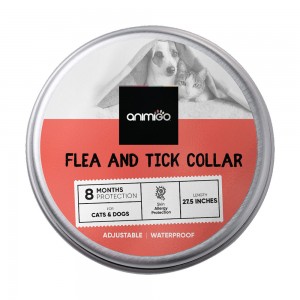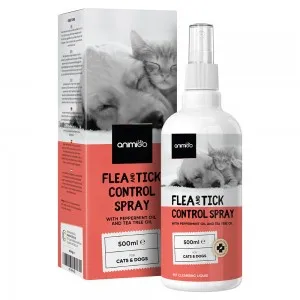100% Customer Satisfaction
Full 90-day money back guarantee
Free UK Delivery
Enjoy free shipping on orders above £30
Natural & Delicious Pet Supplements
Get nutritious, pet-safe & cruelty-free solutions
Filters
Cats
Type
Price
Rating
Fleas & Ticks
All Products In This Category
When it comes to our cats, their happiness and health is our top priority. Nothing beats cuddling up with your cat, hearing them purr, and knowing they're feeling their best. Unfortunately, there are things that want nothing more than to invade your cat's fur and play havoc with their happiness. The culprits? Fleas and ticks. The insidious invaders, sometimes too small to see, are certainly not too tiny to terrorise. When your cat's under attack, who you gonna call? Well, yourself, thanks to this handy little guide. So, put on your reading glasses, or just use your eyes if they're still good, and discover everything you need to know about fleas and ticks: their differences, how to spot their bites, and how to end their reign of terror once and for all.
Recognising Fleas and Ticks
Well, you might be thinking that fleas and ticks are much of a much. They're both small, and they're both happy hitching a ride on your furry feline. But wait, that's not quite right. They are, in fact, not similar at all. Do you want to know how they differ?
Fleas
Undeniably, fleas aren't much to look at. They're tiny and, up close, resemble a plus-sized prawn frozen in tree amber. But don't let their appearance fool you. Just one of these pesky blighters can lay countless eggs, spawning a whole town on your cat's precious coat. The sheer number that can appear within the space of a few days can easily overwhelm your attempts to get rid of them. Flea bites can then lead to irritation on your cat's skin, causing excessive itching.
Your cat is only likely to catch them if they meet a flea-riddled animal, or if they spend time where one recently passed by. It could be a domesticated animal - even another of your pets - or a wild animal. Fleas are also Olympic jumpers who'd put humanity's best to shame. That means even if your cat is simply near a mother flea, they can hop on and start hatching.
The good news is that they're usually easy to spot on your cat's fur, thanks to their sheer number.
Ticks
But if you thought fleas were bad, ho boy. Ticks are like the evil mastermind in a superhero movie. Ticks thrive on blood, or more precisely, the nutrition flowing through your blood. So, they're Dracula. Tiny little Draculas. Unfortunately, this feeding isn't a one-way street. In the process, ticks share saliva through their bite. And since they're not massively fussy about who or what they bite, this can lead to nasty bacteria and viruses being passed to your cat. Yikes.
But ticks don't jump from animal to animal. Instead, they hang out in tall grass and shrubbery above the ground, waiting for a meal to come along. And since they can go for an entire year, they'll be ravenous when your unsuspecting cat brushes past them.
Then, once they've pounced, the tiny creatures will nestle into your cat's fur and bite. Because they're so small and don't hatch like fleas, they can be incredibly difficult to find. However, as they stay put once they've bitten, you may luck out and feel them when you run your fingers through your cat's hair. And yes, that's a little grim.
Signs and symptoms of fleas and ticks on your cat
Cats have very distinct behaviours, so you may notice that something is bothering them before checking for fleas and ticks. However, there are some signs you can spot that point to the evil critters causing a fuss.
Flea bites, for instance, leave large areas of irritated, red skin in their wake. And since they can multiply incredibly quickly, the irritated area will likely be quite large. Your cat will likely be scratching the area incessantly. Some cats are allergic to flea bites, so it's worth checking any parts of your cat that they're scratching.
Ticks, however, are a lot smaller and usually only by themselves. You might not even realise your cat has a tick until their behaviour changes. As ticks take nutrients from the blood, they can sap your cat's energy, and their saliva can actually make them sick. Just keep an eye on your furry feline and see if anything changes.
Flea and tick treatment and prevention for cats
Now that you’re well-versed in the threat fleas and ticks can pose, let's talk about prevention. Below, we've listed a few ways in which you can protect your cat from these tiny enemies.
Treatments
Suds are the answer—specifically, the cleansing suds from a premium shampoo. Fleas and ticks don't stand a chance. Animigo's Flea & Tick Shampoo is made with natural ingredients and is specially formulated to help get rid of fleas and ticks, no matter where they hide. It can reach more difficult areas of your cat, and its soothing formula also helps alleviate skin irritation and soothes the area.
Let's be honest; some cats aren't a huge fan of bathtime. Plus, unlike dogs, they tend to be much better at cleaning themselves, making them even less likely to enjoy being shampooed regularly. So, why not avoid the issue with a Flea and Tick spray? Animigo's got you covered. With Flea & Tick Control Spray, just spray it all over your cat's coat twice a day and see the results for yourself.
Prevention
Of course, you'd probably like your cat to not need flea and tick treatment at all. In that case, add Flea & Tick Defence Powder to their food. Fun fact: fleas and ticks hate garlic. That's why we packed our powder full of it. One whiff, and the little pests will steer clear, leaving your cat free to run, jump, and chase beams of light.
Another alternative is our Flea & Tick Collar. Fitting snuggly around your cat's neck, its natural formula is released throughout the day, repelling fleas and ticks in the process.
Extra Advice
As owners, we like to think we can sort out any issues with our cats ourselves. We are their guardians after all, even if your feline might think otherwise. However, fleas and ticks can be tricky to get rid of, and the damage they can do can be catastrophic. So, if you ever feel like you need to call in the experts, let your vet know. Their expertise could be vital, and if the problem is particularly bad, they can prescribe more potent treatments.
Plus, as you've seen, ticks like to burrow into the skin when they bite. This means that if you try to manually remove them, you can leave the tick's head behind. Unpleasant. This can actually make things worse for your cat, so our advice would be to leave them be, try the above treatments, and if the tick persists, contact your vet.
That's everything! Now you know everything about fleas and ticks, and how to keep your cat safe. Don't worry, you can thank us later.






